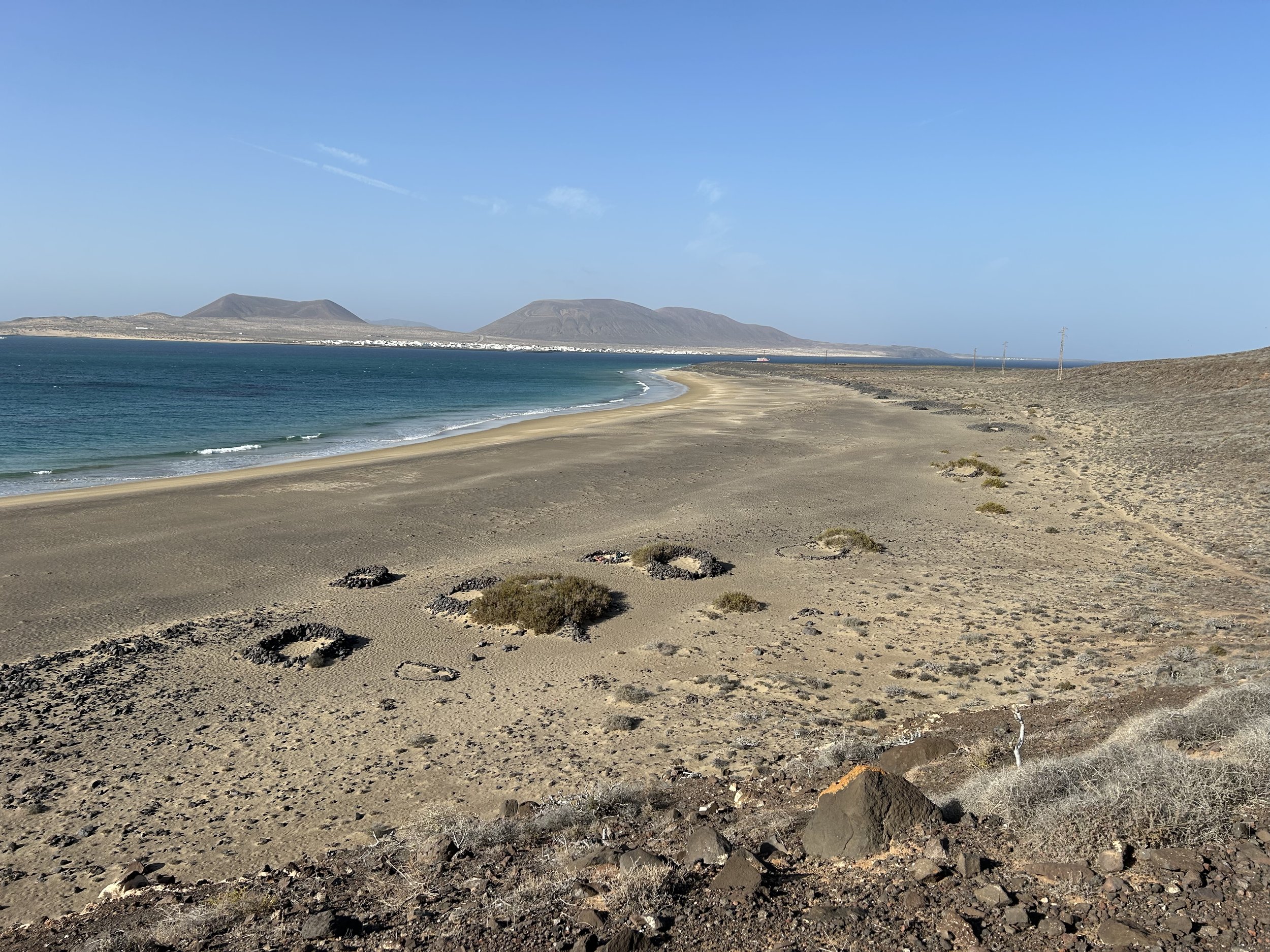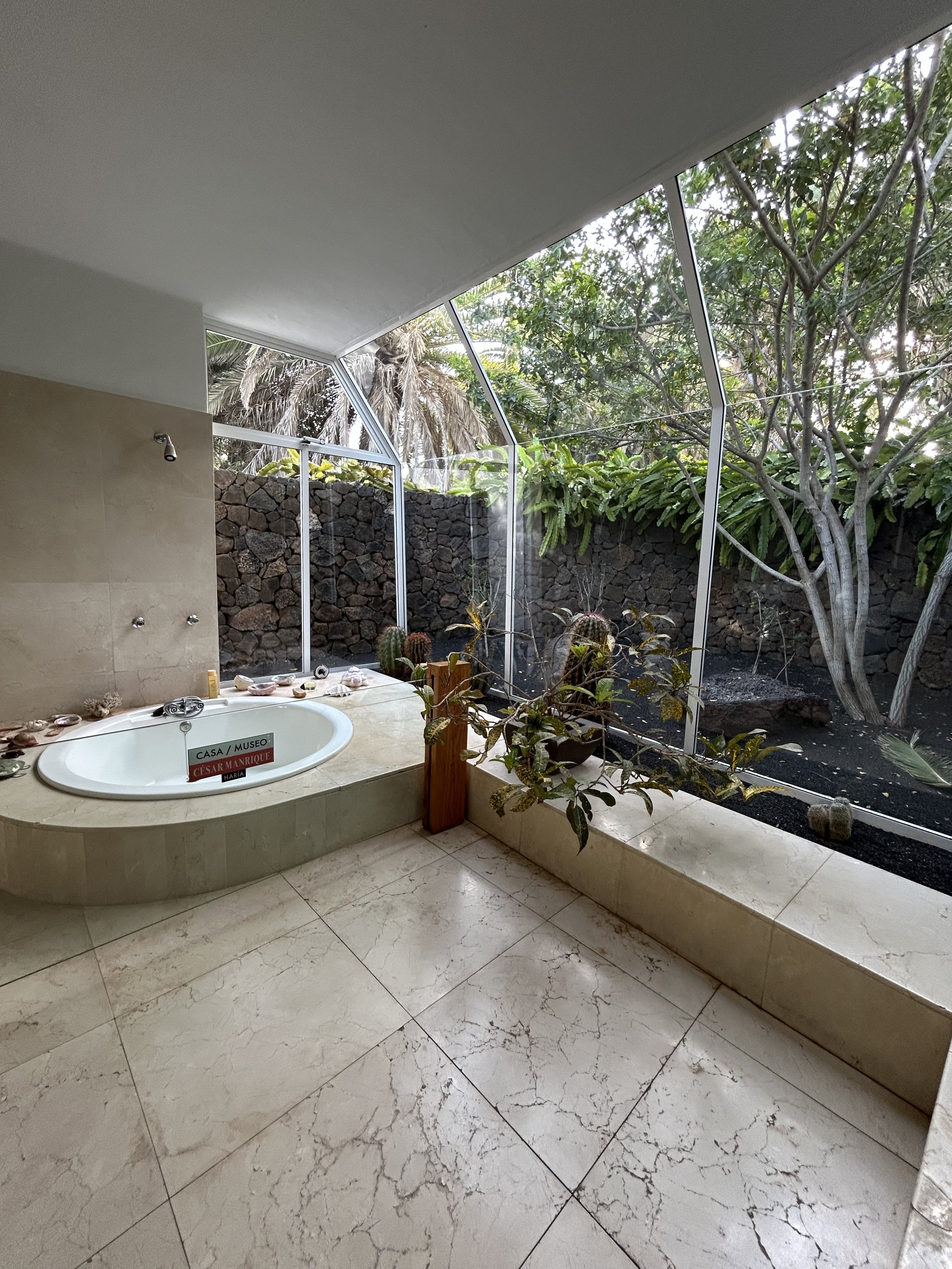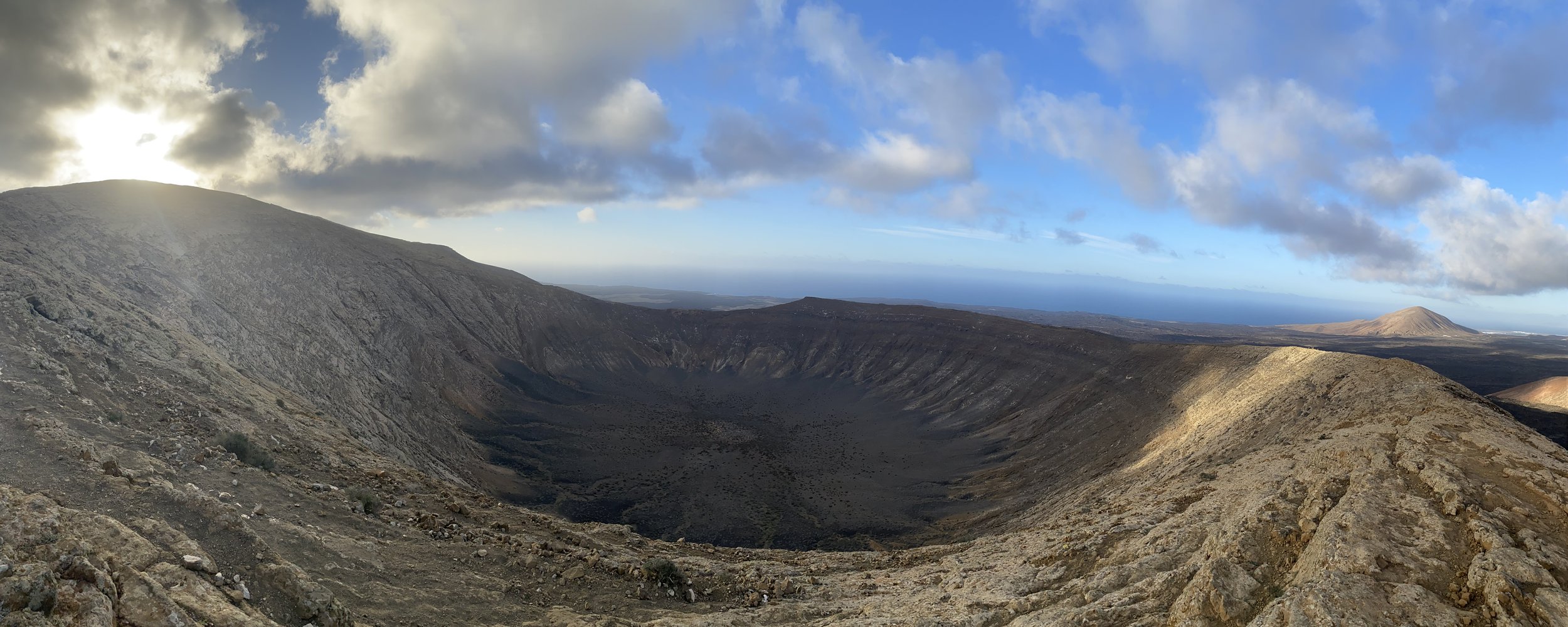Lanzarote: Homecoming 2.0
After 5 days we see land, familiar land. Here we have earned our first sea legs. Coming from the north, Graciosa is the only inhabited secondary island visible alongside Lanzarote itself. We revel in fond memories, as Graciosa was one of the absolute highlights of our 3-week sailing holiday in 2017. The small island with two villages only has sandy roads and there are quad bikes for getting around. There are no cars and no need for them. We skip Graciosa this time and head straight to our first “home marina” - Marina Rubicon - in the very south of Lanzarote. We arrive early in the morning and are immediately greeted by our sailing instructors Chris and Mandy. After 2 months of traveling, it really does feel a bit like coming home.
We have gotten to know and love Lanzarote a little, but as we mainly sailed back then, we want to explore the island even more this time. We spend the first few days catching up with Chris, Mandy and John, a cousin of Chris. We immerse ourselves in their British expat life, take part in the British pub quiz and visit their house, which was designed as a vacation home but is now permanently inhabited. They tell us about their two trips to the Caribbean and their highlights there. Chris has traveled a lot, having served in the British Navy as well as on many sailboat transfers, and gives us tips for the Canary Islands and Mindelo in Cape Verde. Mandy shows us the best supermarkets for provisions. We don't quite realize yet that the big leg across the Atlantic is just around the corner, as we still have 2 weeks on Lanzarote ahead of us.
So as not to get completely bogged down in boat work and preparations, we borrow a 3-wheeled scooter as there is no car for the weekend and drive north with it. There we will spend a night in a lovingly renovated hotel, the Casa de los Naranjos “House of Oranges” in Haria. The north of the island has cast a spell over us during our last visit. Thanks to the artist César Manrique, Lanzarote embarked on a course towards soft tourism at a very early stage and has largely been spared the shabby hotel buildings on the coast, although not in the south-east. From Playa Blanca to Arrecife, mainstream club tourism is relatively pronounced and the coast is also well developed in places. Marina Rubicon is located at the southern end of this zone and is itself very touristy with some huge hotel buildings and vacation home developments. However, the inland and the coast away from this section is very unspoiled, thanks to the artist's early activism. He showed people a different way, an architecture with soul, a fusion of traditional elements with modern influences, but always in harmony with the surroundings. Away from the small traditional settlements and the magical volcanic landscape, it is therefore mainly César's architectural works (there is often no clear distinction between a work of art and a building) that are still admired on the island today.
After a short familiarization phase on our spacy scooter, Ines leads us north with confidence. Our first stop is the wine region. The wine is grown in a unique way in holes dug out of the volcanic ash (approx. 8 m in diameter and 3 m deep) with a small, protective wall facing the wind. The most important variety is Malvasia and since phylloxera never made it to the island, the vines are still purely European. These holes with the small vines characterize the landscape in the central south and create a unique overall picture. This type of viticulture is very labor-intensive due to the narrow pit planting. The wine is therefore relatively expensive (€15 upwards for a bottle). During a visit to an old winery, we learn that slavery was also widespread on these vineyards. Logically, the Canary Islands were one of the first stops on the classic Caribbean route. During this dark period of exploitation, slaves were shipped to the Caribbean and sugar cane, rum, spices and cotton to Europe. We sail the part of this old route towards the Caribbean, but not today, today we continue towards Teguise.
The old capital is more of a picturesque village. We stroll through and enjoy the quaint little houses with a coffee and cake under a tree. We then continue over the first mountains towards the greener part of the island. The road winds its way through the volcanic rocks with spectacular views. Ines fights her way cleanly around every bend on the narrow roads. Haria, our destination for today, welcomes us with a relatively large amount of greenery. It is the village of palm trees, where, according to legend, one palm tree was planted for every girl born and two for every boy born. We check into our hotel. What a luxury! A beautifully renovated property with an old library, reading room, patio and dining room, lovingly restored by a Madrilenian. There are 8 original rooms. For the first time in a long time, we sleep in a bed more than 30 cm wide at the feet and enjoy a shower in a huge, light-flooded bathroom.
After a short rest, we make our way to César Manrique's house. This is the best place to experience his architectural gimmicks up close. The house combines traditional elements with modern ones, such as a flowing transition between the bathroom and the landscape outside. The artist died in the late 90s, but we find his activism extremely contemporary in times like these, when the disconnection between the local population and tourists is leading to protests in many places. The creativity with which he combines buildings and nature is equally impressive. The ideas are almost reminiscent of childlike creativity, which adults often never dare to put into practice.
After the house, we stroll through the village and the small main street is bustling with activity. People are sitting and chatting outside, music is being played - simply wonderful. Today, however, we head to our hotel for a romantic candlelit dinner. After delicious fish and a Canarian roast pork, it's off to our princess bed.
The next day we go on a hike to the beach. We wind our way down a 400 m high cliff to the beach first, knowing full well that the ascent awaits us at the end of the day. The beach rewards us with a variety of landscapes: one part is a mixture of overgrown sand dunes and volcanic rock, while the other is a huge sandy bay with a view of the island of Graciosa, just a stone's throw away. We choose one of the volcanic stone shelters and set up camp. We bathe twice in the beautiful water. We have to get back to our boat today, so we head back up relatively early. It's another one-hour trip back to Rubicon. On Monday morning, we swap our spacy scooter for an electric Fiat 500.
The following day, we set off with our sailing friends Noa and Josef from the Marlin to a volcanic crater in the southwest of the island. This part of the island is barren, shaped by the last huge eruption in 1730-1736, but the craters and the landscape are colorful. Shades of red, black, green lichen and brown. We make it to the summit in time for sunset.
On the boat we have schnitzel pounded with a rubber hammer - 1 kg of pork schnitzel and 1 kg of chicken schnitzel. Served with hand-cut double-fried chips. We spend a nice evening with Noa, Josef, Janine, Micha and Kathie (from the Seven) and eat almost everything.
Tuesdays are our second round of pub quizzes with our sailing instructors. This time we're already more in the mode, we're often very lost in the very British questions, so we mainly enjoy the ambience and the company. At least we can score a few points with music, geography and celebrity faces.
Finally, our friend Stefan arrives, who will accompany us to the Caribbean for 2 months. We pick him up from the airport and a new, sociable chapter begins. Electric car great, what’s not so great - only one of 5 charging stations in Playa Blanca works. So we look for a charging station and find one in a supermarket in Arrecife. We have breakfast there with Stefan, stroll through the town and do the first part of our shopping for the passage in the Hyperdino supermarket. It costs us a phone call to disconnect the car from the power supply, but it's free. Halfway loaded, we speed into the marina. In the evening we have wraps from Kathie, Janine and Micha and the rest of the tuna caught by Noa and Josef on the Seven. On Thursday we go on a short sailing trip with our sailing instructors Chris, Mandy and John. As the weather is rainy and our Canary Islands-spoiled sailing instructors have weaned themselves off the rain, we are back in the harbor after 4 hours. A short but fun trip. In the evening we finally have paella for Ines, as Stefan shares one with her. On Friday we start getting ready and do our first bulk shopping. First we go to the DIY store. We buy riveting pliers, a chain for our dhinghy motor, rubber buckets and locks to lock the lockers. Then it's off to the wholesale food market. There we buy over €600 worth of supplies, from beans to emergency water and around 250 tortillas. Miraculously, we get all the shopping and 3 people into the small electric car.
In the evening we have dinner with two British sailors and John, and for once we don't go to bed too late. On Saturday morning, it's time to clear out the car, as we're planning a tour of the island today. After bringing the 20 bags and 100 liters of water on board, we set off. The first stop is on the barren south-west coast at the Salinas de Janubio. The rectangular boxes of the salt pans with the different drying stages of the salt, which gives each of the boxes a different color, stretch far and wide. We buy some fleur de sal and then head straight to the coast next door. We walk over pointed and sharp lava rocks and watch for a good hour as the waves break on the rocks and the water finds its way. Our next stop is the cactus garden. Here, in a circle set into the ground, a little like an ancient theater, you will find a garden lovingly created by César Manrique with cacti from all over the world.
Lunch is served in Arrieta, a small fishing village. There is one of the reliably functioning charging stations there. So we recharge our batteries in a small restaurant, with fish and steak right by the sea, while our little speedster charges at the fast charger. How easy it is when the charging stations work! Our next stop is Jameos de Agua - a playful work by César that is difficult to describe. He has embedded a bar, a swimming pool, a small house and a spectacular theater in natural volcanic caves. Albino crabs live in the water of the cave.
We then head south again along the west coast via Orzola, a small village on the northern tip. First, however, we watch the spectacular sunset from the cliffs. Afterwards, we enjoy the evening atmosphere in Haria with a beer and later in Teguise in a bar with pintxos (small snacks). We end the evening comfortably on the boat.
Our departure plan is taking shape. We definitely want to leave on Monday. Depending on the situation, to another Canary Island or directly to Mindelo. Then Ines wakes up in the night with a fever. The next day it's a little better and it's mainly a sore throat and cough that remain, but she rests to recover, which means Stefan and I have the athletic program of getting our boat ready for departure. Because 100 liters of water and 10 bags of groceries in our small boat are not enough, we go to the supermarket again (we actually have to return the car and go to get fruit and vegetables beforehand). We return with another 5 bags. A monumental cleaning task begins. Our boat was far from empty before the provisioning, as we still have plenty of supplies from Italy. At first we don't know what to do and it takes until late afternoon for the chaos to clear. In the evening, things look reasonably okay, there is still some work to be done on Monday, but we are optimistic. Ines' condition is at least stabilizing and with a good weather window, we continue to aim for a departure.
Monday is another stressful day. First thing in the morning, back up the mast to replace the broken gennaker furler. Then to the marina office to return tickets for the showers. We have to leave at 11am. With some chaos still on board, we leave our berth to anchor again briefly in front of the marina. We realize that the engine is hot again. So off into the water for a short dive with our Airbuddy, a small compressor that floats with us and supplies me with air via a hose. The salt water inlet is free and working this time, so we check the coolant level, which looks dry. We top up the coolant and test it - the temperature looks good. Then we cook and clear away. Last but not least, Ines cuts both our hair and we give ourselves a biker beard. We leave at 5 p.m. instead of 12 noon. After all not too bad for the fact that there are only two of us working to spare Ines.












































